When the Classic Movie Blog Association (CMBA) announced the topic for its fall blogathon, Trains, Planes and Automobiles, the first images that came to mind were from scenes of trains and in trains from Alfred Hitchcock movies. While the legendary director used all modes of transportation to the advantage of his stories and the peril of his characters it is the train that would serve his special brand of storytelling best.

When Hitchcock made The Lady Vanishes, the final and what many believe is the best of his thriller sextet made up of The Man Who Knew Too Much (1934), The 39 Steps (1935), Secret Agent (1936), Sabotage (1936) and Young and Innocent (1937) he worked with a seriously limited budget. All made at Gaumont-British Picture Corporation it’s astounding to consider all of these films and the indelible mark Hitchcock made on the world-wide motion picture industry given his limitations. But of course this is Hitchcock and there’s not a loser in this lot of films. The Lady Vanishes, however, deserves a special mention here because aside from it being considered the best of the sextet – although I also love The 39 Steps – its story is almost entirely set on a train. The plot is quite simple: While traveling on a train a nice, innocent-looking old lady vanishes after a younger woman traveling on the same train befriends her. Though several people had witnessed the lady’s presence on the train it is questionable whether she was a figment of the younger woman’s imagination because no clues can be found as to her existence. Or, more accurately, no clues anyone else would admit to. That simple plot plus lots of memorable characters were all filmed primarily in one, real rail car with the rest of the scenery created by the use of transparencies, miniatures and back projection to (believably) stand in for continental Europe.

Hitchcock would confirm that the entire set of The Lady Vanishes was 90 feet long, but one would never guess it. In fact, I like to think that what resulted from those limitations, which is a fantastically entertaining and dynamic film encouraged Alfred Hitchcock to use space confinement as a way to enhance tension in his movies for the entirety of his career. That limitation, the stifling of characters and spaces that would reach its apex in what I believe is his ultimate masterpiece, Rear Window (1954) was perfected on a train.
Locations and settings used by Alfred Hitchcock in his films say a lot about the importance of everything visual and that is what mattered most to him. In a Hitchcock film a location is not merely a background or surrounding, but an integral part of the story and scene. With that in mind I consider the Hitchcock train, which would come to represent a host of things in his films. To start and perhaps most obvious – the train makes a natural setting for chases and intrigue. The fact that a moving train poses problems with escape, that its limited space adds friction between characters and presents a natural setting for the famous Hitchcock close-ups and so forth are all elements used to perfection. A moving train also adds thrill to the thriller with the instability creating the perfect tool by which evil and good can suddenly be on an equal playing ground. The final showdown between Charlies in Shadow of a Doubt (1943) comes to mind with the smaller, lovely Charlie able to better the bigger, evil one at the end. How that evil Charlie meets his end is icing on the rails with the image of the oncoming train as he falls leaving a lasting impression. Add “there’s no coming back from being crushed by two trains” to the thrill of the lumbering mode of transport.
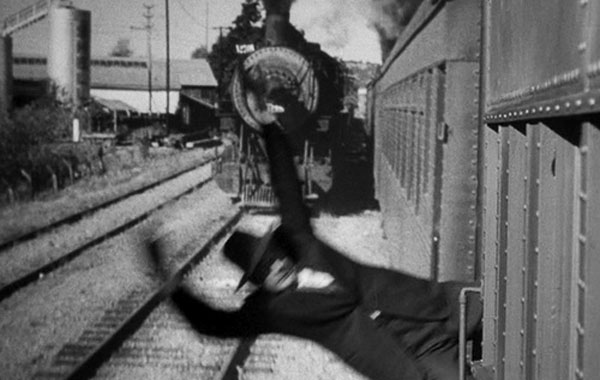
And speaking of platforms… (just play along) – as far as settings go a train platform can say lots about a character and a visual master like Hitchcock takes advantage of that in the great opening to Marnie (1964). That movie opens with an extreme closeup of a yellow purse while we hear the clatter of a woman’s heals walking briskly. Suddenly the camera stays still and the woman keeps walking forward – the closeup turns wider and wider until we’re able to see where she is. An immediate cut to the next scene wherein a man is describing a robbery and we know what the woman has done and why she was walking briskly. Using trains to escape the authorities is done by many a Hitchcock villain and/or “wrong man.”
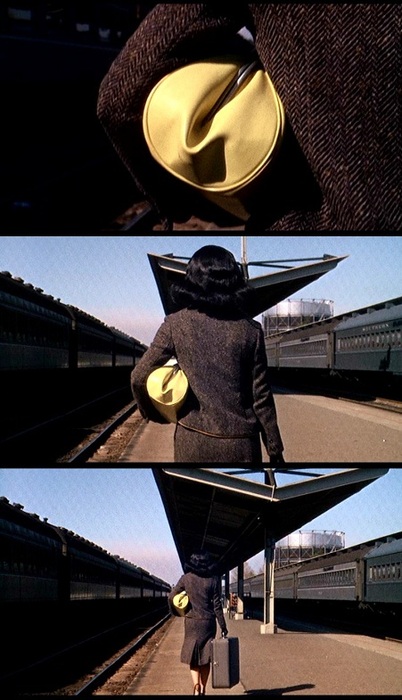
Hitchcock also used trains as warnings of impending doom and I again defer to his own favorite movie, Shadow of a Doubt for the best example of this. When Uncle Charlie’s train pulls into the otherwise run-of-the-mill American town he brings with him much more than gifts for the entire family as shown by the thick, black smoke that permeates the otherwise clear sky. You can’t say “There goes the neighborhood!” any clearer.
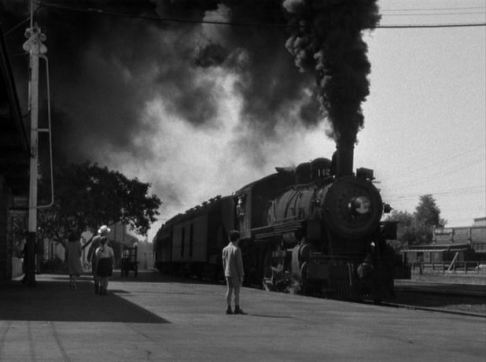
Train whistles can also be quite similar to shrieks in worlds created by Hitchcock. My favorite example of this comes at the beginning of The 39 Steps when a landlady finds the body of the murdered woman. Naturally her reaction is to scream in horror, a scream which then morphs into a train whistle as that scene fades to the next. Hitchcock also used a train whistle to similar effect throughout the journey depicted in The Lady Vanishes and the “shriek” never fails to startle.
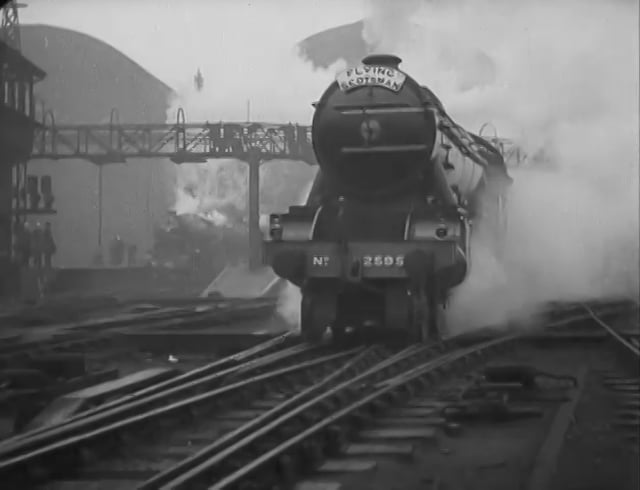
The claustrophobia offered by trains is also a perfect way for people from all walks of life to meet, which offers plenty of opportunity to show shady, suspicious characters to add to the mystery of a story. An added bonus is it also allows for comic characters to intermingle with suspicious types and thereby adding the necessary Hitchcock humor to the mix. In short, all sorts of bonds are formed at any moment when a crowd is forced into a rail car, but the most intriguing pairings that occur on Hitchcock trains are those of a romantic nature. For instance on a train is where Hannay (Robert Donat) first meets Pamela (Madeleine Carroll) in The 39 Steps, where he reads the newspaper stories of the murder that occurred in his apartment the day before and is subsequently able to escape detection by kissing the cool, blonde stranger with whom he will soon be linked.

Several years later we see a bookish Lina (Joan Fontaine) meet Johnnie (Cary Grant), an extraordinarily handsome man who suspiciously enters her first-class train compartment in Suspicion (1941). This scene opens the movie with some of the humor I mentioned as the screen fades to black immediately following the ‘Directed by Alfred Hitchcock’ credit. We see Lina and Johnnie as the train comes out of a dark tunnel – she’s staring at him and he’s looking for something in the upper bunk area.

That “chance” meeting leads to all sorts of intrigue, but it’s the familiar Hitchcock humor on a train that kicks things off before Lina is charmed into a worrisome existence.

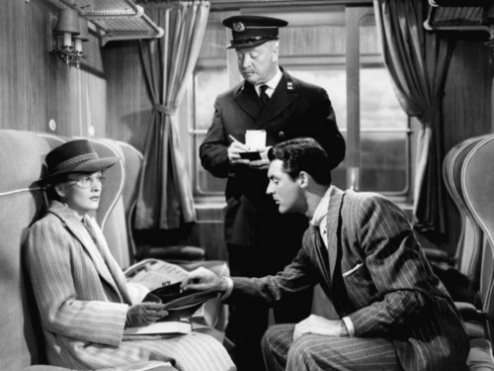
Several years after that Cary Grant is seduced by Eva Marie Saint in North by Northwest (1959) while trying to escape detection. The temperature in the dining car goes up by several degrees after Saint’s honest woman (Eve Kendall) confesses it’s no coincidence Grant (as Roger Thornhill) is seated across the table from her. Direct and to the point is the lady and director who would use the train to showcase the entirety of the pair’s romantic relationship – from seduction…
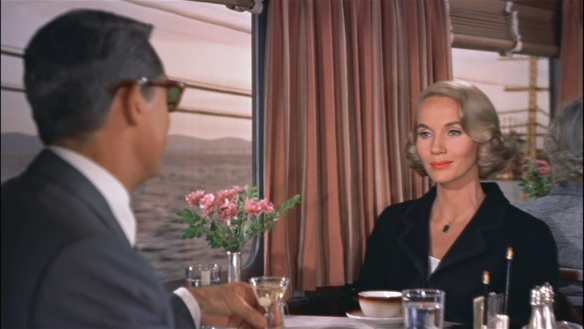
to foreplay…


to consummation…

…All while the chase, danger and intrigue are ever-present in the narrow corridors of a moving train…
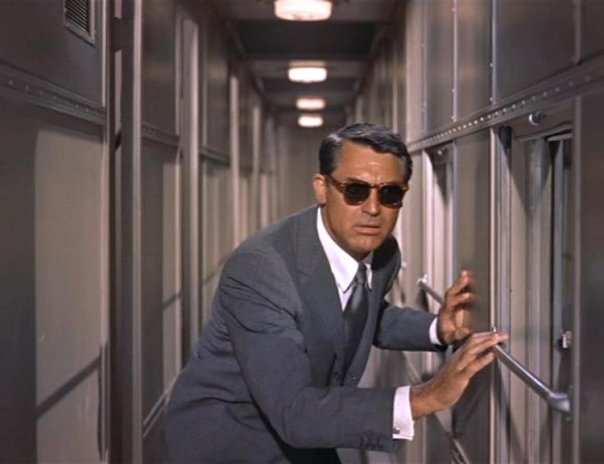
From one wrongfully accused man we move onto another except this one is Robert Cummings in Saboteur (1942) being chased almost two decades earlier than Cary in North By Northwest. Cummings plays Barry Kane, an aircraft factory worker who goes on the run after he is wrongfully of killing a friend as an act of sabotage. This man on the run uses all modes of transportation in hopes of saving his hide and getting to the real bad guys, but there is a train-like scene in the movie so it merits a mention here. I say “train-like” because what I allude to as a train is actually referred to as a bus in the movie. But to me it’s train-like and the scene it is featured in is similar to many other Hitchcock train scenes – so…
While Barry is on the run he and Pat (Priscilla Lane, the girl) run into a slow-moving caravan/train transporting a circus. Barry, who’s handcuffed and Pat who’s an unwilling travel companion jump onto the last car, which is inhabited by the circus performers who vote on whether they should turn him into the authorities.
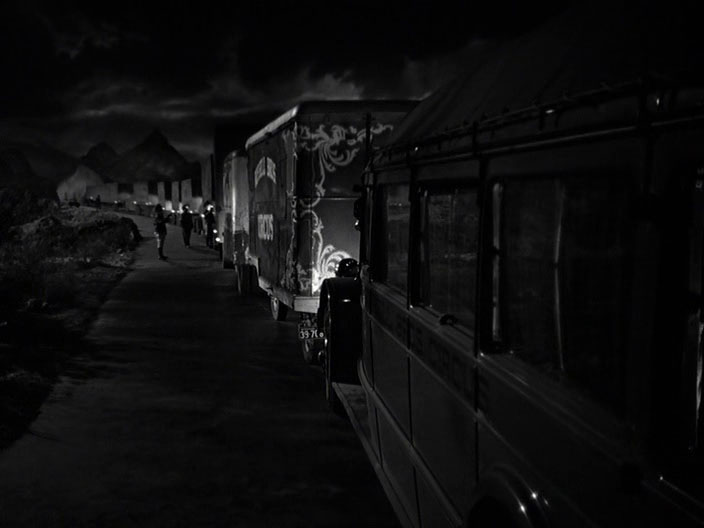

Next we visit a train mixed up in psychoanalysis when it is discovered that a railway station plays a pivotal role in the care of one John Ballantyne (Gregory Peck) in Spellbound (1945). Having left the institution where Dr. Constance Peterson (Ingrid Bergman) was treating him Ballantyne is forced to retrace the steps taken and words spoken at a ticket booth.

Dr. Petersen continues her psychoanalysis of Ballantyne on the train to Rochester, New York where the two plan to meet with Peterson’s mentor. The session turns into a fascinating blend of analysis and romance and proves useful when the sight of the tracks whooshing by cause long-lost memories to resurface for Ballantyne. Another piece of his memory puzzle falls into place – on a train.
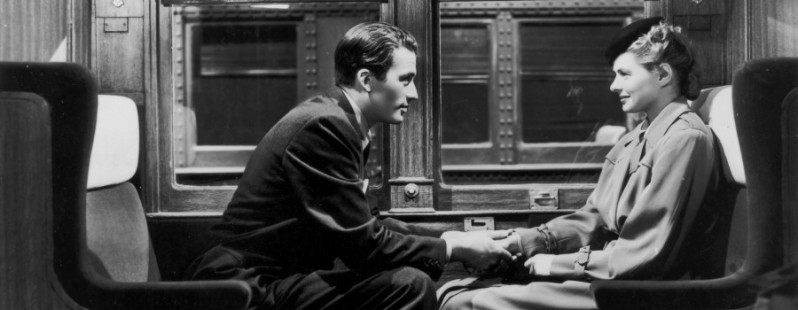
I end this visit with Hitchcock trains with the PIÈCE DE RÉSISTANCE of stories born of trains. That is, of course, the brilliant and eerie Strangers on a Train (1951) and for my money the best film opening sequence ever.
Two sets of legs walk through a train station toward the train for departure. Random. It could be any two of us. Next we see a shot of train tracks crisscrossing from the point of view of the train which chooses the right track – or, rather the track on the right. But what if it had gone left? Crisscrossing tracks and crisscrossing lives.
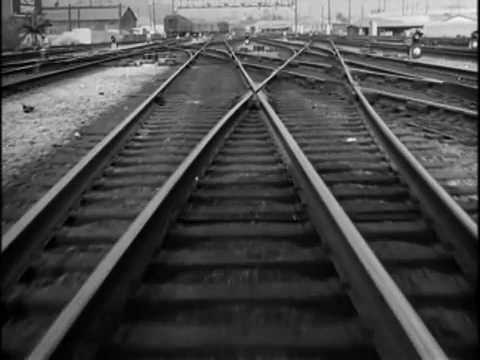
The theme is established from the onset with visuals in a glorious montage – another Hitchcock gift. As is the real, deep down creepiness of this movie, which comes from the fact that it all starts with a chance meeting, something that can happen to any of us.

The premise is a simple, murderous quid-pro-quo – you commit my murder and I’ll commit yours. This is a deal like so many other business dealings on trains except this one is in a Hitchcock movie and it involves the perfect murder. The perfect ending to this Hitchcock train homage.
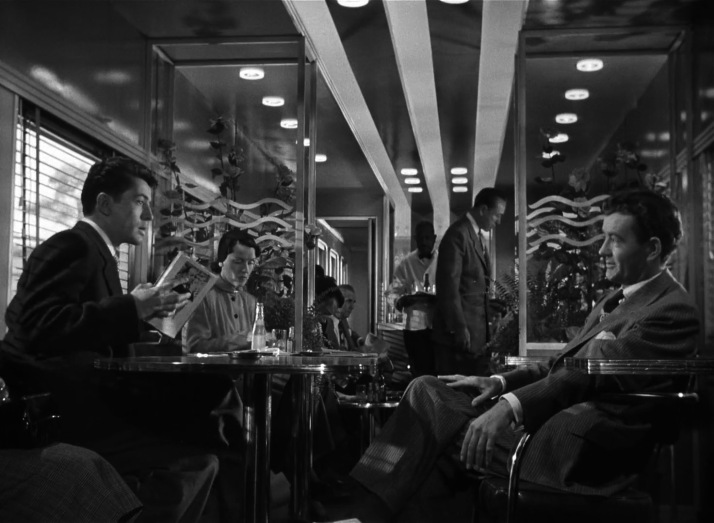
♦
Hitchcock Train Cameos
Whether it’s the boxcar or the platform Alfred Hitchcock also fit quite smoothly into the train motif as part of the action where he would often make his famous cameo appearance. Following are the ones associated with trains.
One of my favorite of the Hitchcock cameos is from his (and Britain’s) first talking picture, 1929’s Blackmail. Using his signature humor we see the director reading as a passenger on the London Underground when a little boy kneels on the seat in front of him and suddenly pulls his hat down over his face.
Blackmail (1929)


The stranger (Hitchcock) briefly complains to the boy’s mother, but she pays no mind and soon the boy turns around again and is met with a glare.

In The Lady Vanishes Hitch is seen among the passersby at Victoria Station carrying a curious little bag.

In Shadow of a Doubt the director is playing cards on the train to Santa Rosa.

Holding a royal flush no less!

In The Paradine Case (1947) Hitchcock makes his cameo appearance getting off a train at the Cumberland station carrying a cello with a similar look as his cameo in Strangers on a Train.
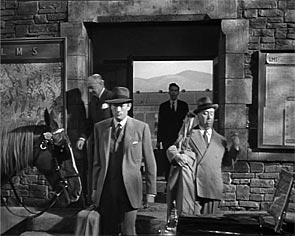
Finally in Strangers on a Train Hitch nearly runs into Guy while struggling to get his cello on board.



♦
Take the nearest transpo available and head on over to the CMBA where a fantastic array of posts await all about Planes, Trains And Automobiles.

IMPORTANT: Consider purchasing this fantastic eBook for a great cause!
Selected pieces are available in the Planes, Trains & Automobiles eBook, available for free at Smashwords and on Amazon for $0.99, with all profits going towards the National Film Preservation Foundation.

Wow! This post deserves an Oscar! One of the best ever, so comprehensive, with terrific illustrations. Thank you so much .
Thank YOU for your lovely comments and support, Vienna! 🙂 I’m glad you liked this – it was fun to do, but hell to not write a lot about each film. What an eye this guy had!!
Aurora
Great idea and wonderfully execution. Hitchcock had some of the best trains scenes in all of cinema.
Thanks so much, John! He sure did. As I mentioned in my reply to Vienna it was difficult to just pick a relative few. The Lady Vanishes alone has dozens of memorable train scenes.
Aurora
Wonderful overview of the numerous, brilliant ways that Hitchcock used trains! He certainly did have a thing for them! Thanks for a great post!
Thanks! So glad you liked this. 🙂
Aurora
I really enjoyed your thorough and entertaining look at some of the best, and truly memorable, moments from Hitchcock.
Thanks, Paddy! This was fun to do. 🙂
Aurora
What a great post! To tally up Hitchcock’s train scenes, that is quite a feat. Wonderful attention to detail. This was swell.
Thank so much, Jacqueline. It was a lot of fun to do.
Aurora
Ack! You’re a positive blogathon-theme genius! I seriously loved this post (and many thanks for posting pictures of my husband Cary. Did you know he practiced those moves with Eva Marie Saint on me?).
You started off so well then just fell WAY OFF! Um…no I didn’t cuz he didn’t! SHEESH!
Nice points. It’s true that Hitchcock seemed to have had a train obsession, as he features them so much in his films.
Tam
They’re perfect for him! And his cameos. 🙂 THANKS for stopping in. 🙂
Very fun review about Hitch’s various uses for a train. I love them all, but the most audacious has to be that closing shot in N By NW!
Thanks, Rick and yeah…no doubt. Still love that final shot tho.
Brilliant post, Aurora. I love how you collected all these memorable train scenes for us.
I especially liked your observation on the black smoke accompanying Uncle Charlie’s arrival in Shadow of a Doubt. “There goes the neighbourhood” indeed!
Thanks, Ruth! As much as I adore the whole of Shadow of a Doubt that black smoke shot has always been one of my favorites and the reason I thought of doing this homage to Hitch on a train. 🙂
Aurora
This is the best post in the blogathon! A thoroughly enjoyable read. 🙂
Thanks so much, Constance! I’m glad you enjoyed this. 🙂
This was such a wonderful piece. I love the atmosphere trains add to those classic films; you captured that beautifully in this post. You clearly love these films. I recognized most of them, and it makes me want to set aside a night for re-watching some old favorites. The images you have add so much here.
Thank you much for your kind words. I’m happy to know you enjoyed it. I DO love these movies! 🙂
Man, that is a terrific essay. Great idea, excellent observations and analyses. Thanks for that, I really enjoyed it! Most illuminating, Aurora, most illuminating…
Many thanks, Lesley. Glad you liked it. It was fun to do.